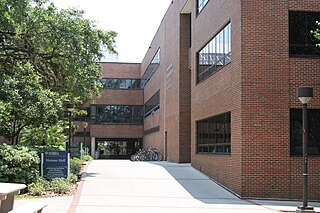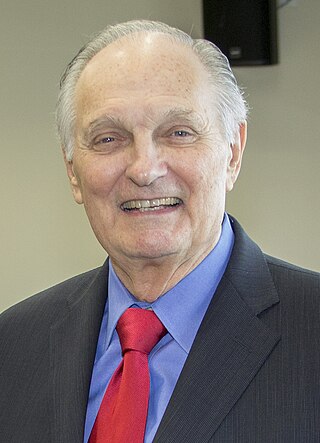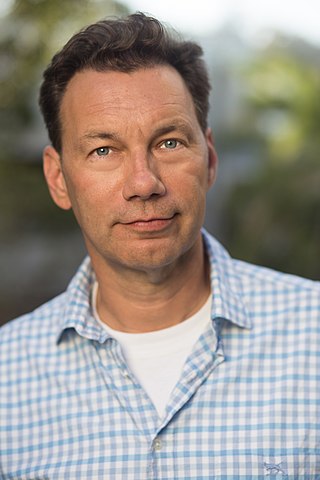
Improvisational theatre, often called improvisation or improv, is the form of theatre, often comedy, in which most or all of what is performed is unplanned or unscripted, created spontaneously by the performers. In its purest form, the dialogue, action, story, and characters are created collaboratively by the players as the improvisation unfolds in present time, without use of an already prepared, written script.

Stony Brook University (SBU), officially the State University of New York at Stony Brook, is a public research university in Stony Brook, New York. Along with the University at Buffalo, it is one of the State University of New York system's two flagship institutions. Its campus consists of 213 buildings on over 1,454 acres of land in Suffolk County and it is the largest public university in the state of New York.

Paul Christian Lauterbur was an American chemist who shared the Nobel Prize in Physiology or Medicine in 2003 with Peter Mansfield for his work which made the development of magnetic resonance imaging (MRI) possible.

IBM Research is the research and development division for IBM, an American multinational information technology company headquartered in Armonk, New York, with operations in over 170 countries. IBM Research is the largest industrial research organization in the world and has twelve labs on six continents.

Stony Brook University Hospital (SBUH), previously known as Stony Brook University Medical Center, is a nationally ranked, 695-bed non-profit, research, and academic medical center located in Stony Brook, New York, providing tertiary care for the entire Long Island region. The medical center is a part of the Stony Brook Medicine Health System and is made up of four hospitals that include the Stony Brook University Hospital, Stony Brook Children's Hospital, Stony Brook Southampton Hospital, and Stony Brook Eastern Long Island Hospital. SBUH is affiliated with the Renaissance School of Medicine at Stony Brook University. Long Island's only tertiary care and a Level 1 Adult and Pediatric Trauma Center, the hospital is ranked as the 12th best in New York and 10th in the New York metropolitan area by U.S. News & World Report. The hospital campus also includes a rooftop helipad to better serve critical cases.
The actor model in computer science is a mathematical model of concurrent computation that treats an actor as the basic building block of concurrent computation. In response to a message it receives, an actor can: make local decisions, create more actors, send more messages, and determine how to respond to the next message received. Actors may modify their own private state, but can only affect each other indirectly through messaging.

Environmental communication is "the dissemination of information and the implementation of communication practices that are related to the environment. In the beginning, environmental communication was a narrow area of communication; however, nowadays, it is a broad field that includes research and practices regarding how different actors interact with regard to topics related to the environment and how cultural products influence society toward environmental issues".
The Public Welfare Medal is awarded by the U.S. National Academy of Sciences "in recognition of distinguished contributions in the application of science to the public welfare." It is the most prestigious honor conferred by the academy. First awarded in 1914, the medal has been awarded annually since 1976.
Joanna Sigfred Fowler is a scientist emeritus at the U.S. Department of Energy's Brookhaven National Laboratory in New York. She served as professor of psychiatry at Mount Sinai School of Medicine and director of Brookhaven's Radiotracer Chemistry, Instrumentation and Biological Imaging Program. Fowler studied the effect of disease, drugs, and aging on the human brain and radiotracers in brain chemistry. She has received many awards for her pioneering work, including the National Medal of Science.

Science communication encompasses a wide range of activities that connect science and society. Common goals of science communication include informing non-experts about scientific findings, raising the public awareness of and interest in science, influencing people's attitudes and behaviors, informing public policy, and engaging with diverse communities to address societal problems. The term "science communication" generally refers to settings in which audiences are not experts on the scientific topic being discussed (outreach), though some authors categorize expert-to-expert communication as a type of science communication. Examples of outreach include science journalism and health communication. Since science has political, moral, and legal implications, science communication can help bridge gaps between different stakeholders in public policy, industry, and civil society.

The College of Journalism and Communications (CJC) is an academic college of the University of Florida. The centerpiece of the journalism programs at UF is WUFT, which consists of both a WUFT (TV) Public Broadcasting Service (PBS) Public television and WUFT-FM NPR public radio station. The commercial broadcasting radio station, WRUF, is also one of the oldest stations in the state.

Alan Alda is an American actor, comedian, screenwriter, podcast host, and director. A six-time Emmy Award and Golden Globe Award winner and a three-time Tony Award nominee, he is best known for playing Captain Benjamin Franklin "Hawkeye" Pierce in the CBS wartime sitcom M*A*S*H (1972–1983). He also wrote and directed numerous episodes of the series.

David Morrison is an American astronomer, a senior scientist at the Solar System Exploration Research Virtual Institute, at NASA Ames Research Center in Mountain View, California. Morrison is the former director of the Carl Sagan Center for Study of Life in the Universe at the SETI Institute and of the NASA Lunar Science Institute. He is the past Director of Space at NASA Ames. Morrison is credited as a founder of the multi-disciplinary field of astrobiology. Morrison is best known for his work in risk assessment of near Earth objects such as asteroids and comets. Asteroid 2410 Morrison was named in his honor. Morrison is also known for his "Ask an Astrobiologist" series on NASA's website where he provides answers to questions submitted by the public. He has published 12 books and over 150 papers primarily on planetary science, astrobiology and near Earth objects.

Brian Palermo is an American character actor, science communicator, improv instructor and comedian. He has appeared in a number of television shows, commercials and movies. Palermo is also a writer whose credits include Warner Brothers' Histeria! and Disney's The Weekenders and Dave The Barbarian, both created by Doug Langdale. He is also a co-author with Randy Olson and Dorie Barton of the 2003 book, Connection: Hollywood Storytelling Meets Critical Thinking.
Alan C. Miller is a Pulitzer Prize-winning American journalist and the founder of the News Literacy Project, a national education nonprofit that works with educators and journalists to offer resources and tools that help middle school and high school students learn to separate fact from fiction. In 2020, NLP expanded its audience to include people of all ages.

The Renaissance School of Medicine (RSOM) is the graduate medical school of Stony Brook University located in the hamlet of Stony Brook, New York on Long Island. Founded in 1971, RSOM is consistently ranked the top public medical school in New York according to U.S. News & World Report. RSOM is one of the five Health Sciences schools under the Stony Brook Medicine healthcare system.
Benjamin S. Hsiao is an American materials scientist and educator. He served as the vice-president for research and chief research officer at Stony Brook University from May 2012 to December 2013.
Esther Sans Takeuchi is a materials scientist and chemical engineer, working on energy storage systems and power sources for biomedical devices. She is also a distinguished professor at Stony Brook University and a chief scientist at Brookhaven National Laboratory. She holds more than 150 U.S. patents. “The battery was invented once and reinvented over 100 times. I don’t own the patent. The company does. It was called Greatbatch. Now it’s called Integer Corp. When you join a company, you sign over your patent rights to the company.”
Dmitri E. Kharzeev is an American theoretical physicist most notable for his work on the chiral magnetic effect.

The campus of Stony Brook University is located in Stony Brook, New York, and consists of 213 buildings over 1,454 acres of land. It is the largest public university in the state of New York in terms of land area. The campus was moved to Stony Brook in 1962 after originating in Oyster Bay, New York.













